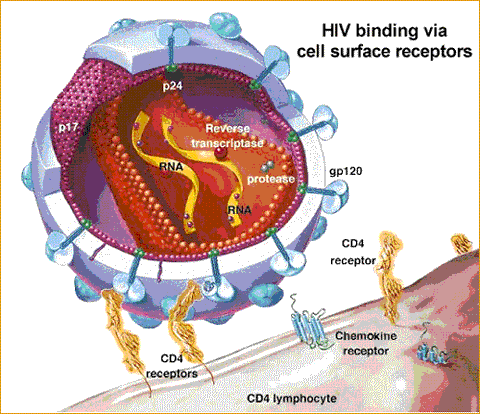Team:NYMU-Taipei/Project/Receptor/CD4
From 2009.igem.org
| Home | Project Overview: | Chassis | Receptors | Removal | Experiments and Parts | F.A.Q | About Us |
Contents |
Motivation
Virus have a high mutation rate, so our immune system can not always detect mutated viruses. But virus capsid proteins have some specific binding proteins that viruses use to enter into human cells. There are some highly conserved regions on the virus proteins, since mutations of these regions will never be worth it for the viruses since the viruses will not be able to enter human cells and survive.
In our ViroCatcher, we want to express human receptors that interact with HIV. In addition, we have to check the folding of the target receptors, because our receptors from human cells would have to express in bacteria. Eventually, to make contact with receptors of HIV, we have to anchor the receptors on the membrane of our ViroCatcher.
Goal
Use the receptors on human cells that bind to HIV, and put them on our ViroCatcher to catch HIV.
Receptors used to catch HIV
Previous study indicate that HIV absorb T cell and macrophage by their envelope glycoprotein[1,2], and insert a fusion peptide into target cell to change their membrane structure. Changing of membrane structures will help the fusion between the HIV envelope and the target cell membrane. The CD4 receptor of macrophage and T cells are the main target of HIV. HIV attaches onto human cells using their gp120 protein. The binding causes a shift of conformation on gp120 that allows the connection between gp120 and the co-receptor CCR5 or CXCR4[1,2].

figure from website:http://www.bio.davidson.edu/Courses/Molbio/MolStudents/spring2003/Cobain/geneprotein.html
We express the two receptors CD4 and CCR5 on our ViroCatcher membrane and use autotransporter system to anchor the receptors on the membrane of our ViroCatcher.
- [http://www.ncbi.nlm.nih.gov/CCDS/CcdsBrowse.cgi?REQUEST=CCDS&ORGANISM=0&BUILDS=CURRENTBUILDS&DATA=CCDS8562.1 CD4 sequence]
1 atgaaccggg gagtcccttt taggcacttg cttctggtgc tgcaactggc gctcctccca
61 gcagccactc agggaaagaa agtggtgctg ggcaaaaaag gggatacagt ggaactgacc
121 tgtacagctt cccagaagaa gagcatacaa ttccactgga aaaactccaa ccagataaag
181 attctgggaa atcagggctc cttcttaact aaaggtccat ccaagctgaa tgatcgcgct
241 gactcaagaa gaagcctttg ggaccaagga aactttcccc tgatcatcaa gaatcttaag
301 atagaagact cagatactta catctgtgaa gtggaggacc agaaggagga ggtgcaattg
361 ctagtgttcg gattgactgc caactctgac acccacctgc ttcaggggca gagcctgacc
421 ctgaccttgg agagcccccc tggtagtagc ccctcagtgc aatgtaggag tccaaggggt
481 aaaaacatac agggggggaa gaccctctcc gtgtctcagc tggagctcca ggatagtggc
541 acctggacat gcactgtctt gcagaaccag aagaaggtgg agttcaaaat agacatcgtg
601 gtgctagctt tccagaaggc ctccagcata gtctataaga aagaggggga acaggtggag
661 ttctccttcc cactcgcctt tacagttgaa aagctgacgg gcagtggcga gctgtggtgg
721 caggcggaga gggcttcctc ctccaagtct tggatcacct ttgacctgaa gaacaaggaa
781 gtgtctgtaa aacgggttac ccaggaccct aagctccaga tgggcaagaa gctcccgctc
841 cacctcaccc tgccccaggc cttgcctcag tatgctggct ctggaaacct caccctggcc
901 cttgaagcga aaacaggaaa gttgcatcag gaagtgaacc tggtggtgat gagagccact
961 cagctccaga aaaatttgac ctgtgaggtg tggggaccca cctcccctaa gctgatgctg
1021 agtttgaaac tggagaacaa ggaggcaaag gtctcgaagc gggagaaggc ggtgtgggtg
1081 ctgaaccctg aggcggggat gtggcagtgt ctgctgagtg actcgggaca ggtcctgctg
1141 gaatccaaca tcaaggttct gcccacatgg tccaccccgg tgcagccaat ggccctgatt
1201 gtgctggggg gcgtcgccgg cctcctgctt ttcattgggc taggcatctt cttctgtgtc
1261 aggtgccggc accgaaggcg ccaagcagag cggatgtctc agatcaagag actcctcagt
1321 gagaagaaga cctgccagtg tcctcaccgg tttcagaaga catgtagccc catttga
outer primer (forward) contain ompA sticky tag
GCACTCGTCCGGACAAC(56deg, 65%, 17bp)ATGAACCGGGGAGTCC(54deg, 63%, 16bp)
outer primer (reverse)
ctgcagcggccgctactagta AATGGGGCTACATGTCTTCT 55deg, 45%, 20bp
- [http://www.ncbi.nlm.nih.gov/CCDS/CcdsBrowse.cgi?REQUEST=CCDS&ORGANISM=0&BUILDS=CURRENTBUILDS&DATA=CCDS2739.1 CCR5 sequence]
1 atggattatc aagtgtcaag tccaatctat gacatcaatt attatacatc ggagccctgc
61 caaaaaatca atgtgaagca aatcgcagcc cgcctcctgc ctccgctcta ctcactggtg
121 ttcatctttg gttttgtggg caacatgctg gtcatcctca tcctgataaa ctgcaaaagg
181 ctgaagagca tgactgacat ctacctgctc aacctggcca tctctgacct gtttttcctt
241 cttactgtcc ccttctgggc tcactatgct gccgcccagt gggactttgg aaatacaatg
301 tgtcaactct tgacagggct ctattttata ggcttcttct ctggaatctt cttcatcatc
361 ctcctgacaa tcgataggta cctggctgtc gtccatgctg tgtttgcttt aaaagccagg
421 acggtcacct ttggggtggt gacaagtgtg atcacttggg tggtggctgt gtttgcgtct
481 ctcccaggaa tcatctttac cagatctcaa aaagaaggtc ttcattacac ctgcagctct
541 cattttccat acagtcagta tcaattctgg aagaatttcc agacattaaa gatagtcatc
601 ttggggctgg tcctgccgct gcttgtcatg gtcatctgct actcgggaat cctaaaaact
661 ctgcttcggt gtcgaaatga gaagaagagg cacagggctg tgaggcttat cttcaccatc
721 atgattgttt attttctctt ctgggctccc tacaacattg tccttctcct gaacaccttc
781 caggaattct ttggcctgaa taattgcagt agctctaaca ggttggacca agctatgcag
841 gtgacagaga ctcttgggat gacgcactgc tgcatcaacc ccatcatcta tgcctttgtc
901 ggggagaagt tcagaaacta cctcttagtc ttcttccaaa agcacattgc caaacgcttc
961 tgcaaatgct gttctatttt ccagcaagag gctcccgagc gagcaagctc agtttacacc
1021 cgatccactg gggagcagga aatatctgtg ggcttgtga
outer primer (forward) contain ompA sticky tag
GCACTCGTCCGGACAAC(56deg, 65%, 17bp)ATGGATTATCAAGTGTCAAGTCC (54deg, 39%, 23bp)
outer primer (reverse)
ctgcagcggccgctactagta CAAGCCCACAGATATTTCCTG 55deg, 48%, 21bp
inner primer1
CATTACACCTGtAGCTCTCATT 53deg, 41%, 22bp AATGAGAGCTaCAGGTGTAATG
inner primer2
TTCCAGGAgTTCTTTGGC 53deg, 50%, 18bp GCCAAAGAAcTCCTGGAA
Circuit design
References
1. Chan DC, Kim PS: HIV entry and its inhibition. Cell 1998, 93(5):681-684.
2. Wyatt R, Sodroski J: The HIV-1 envelope glycoproteins: fusogens, antigens, and immunogens. Science 1998, 280(5371):1884-1888.
 "
"
